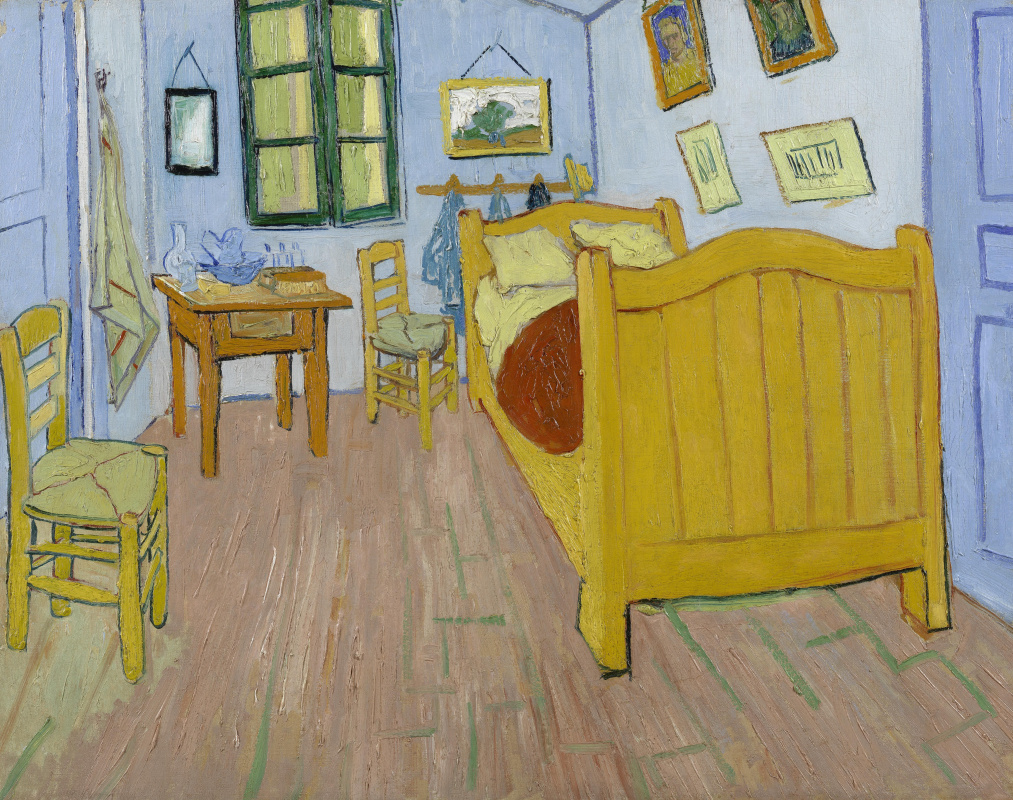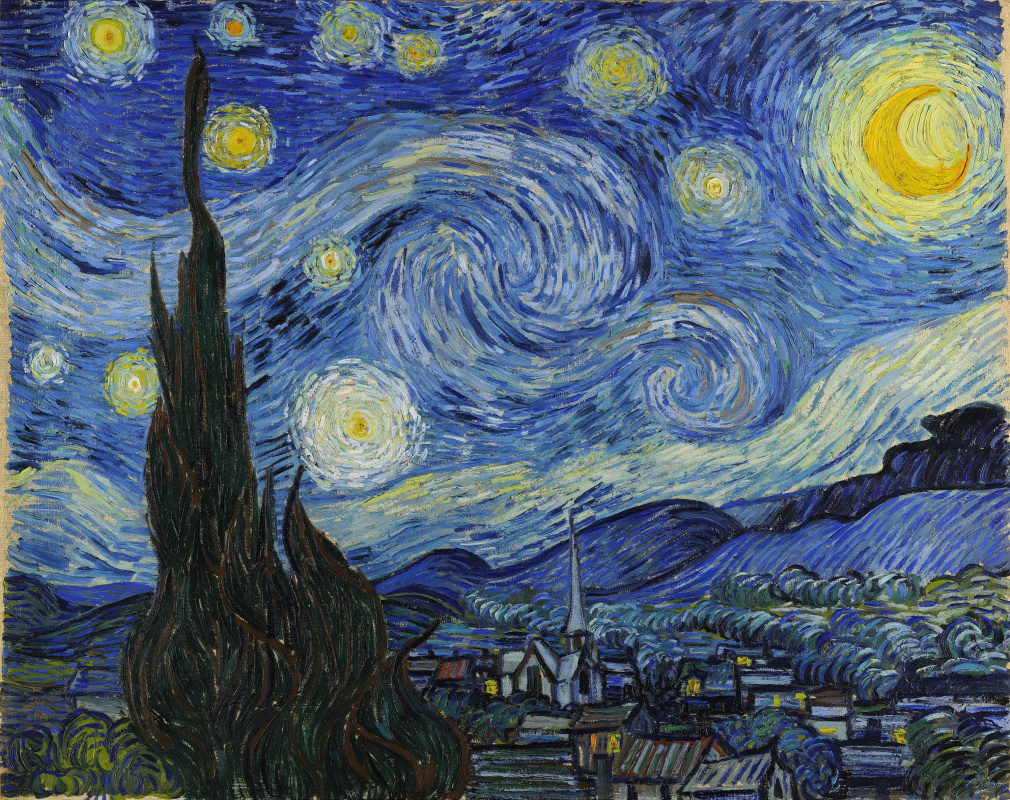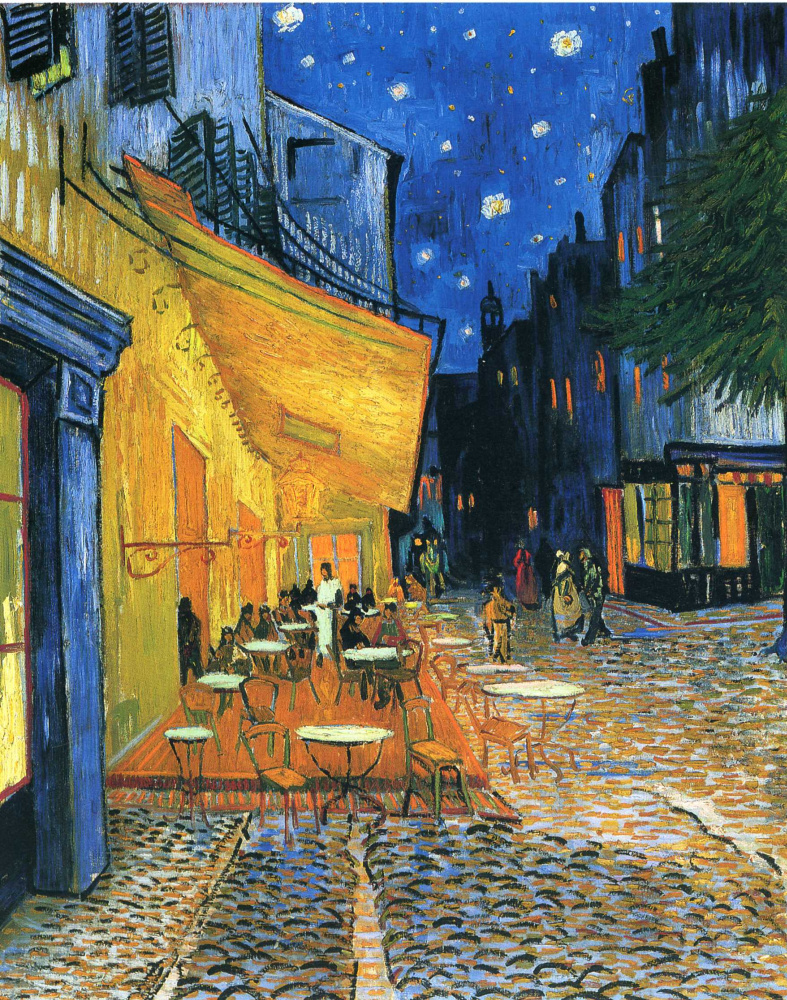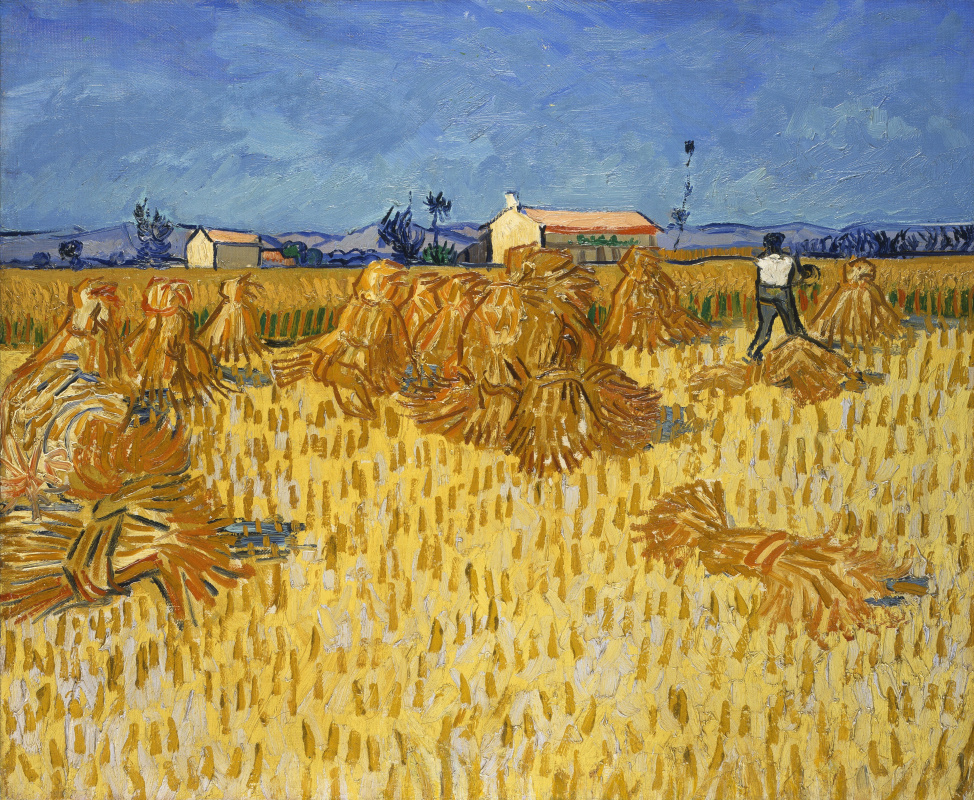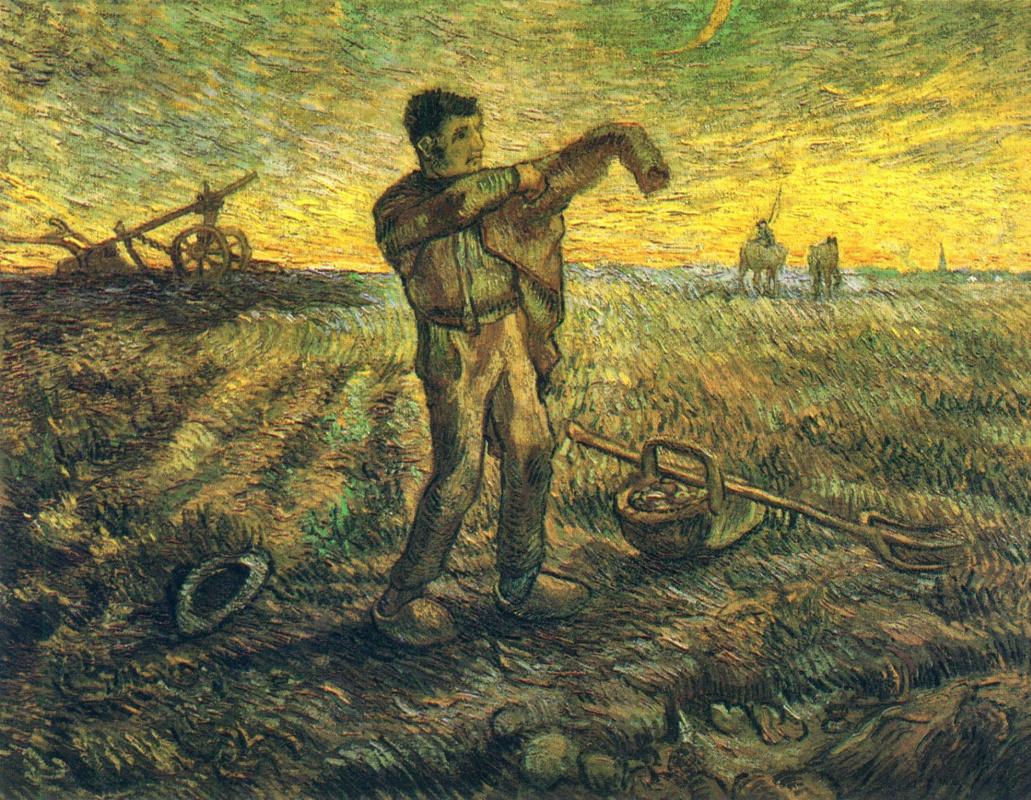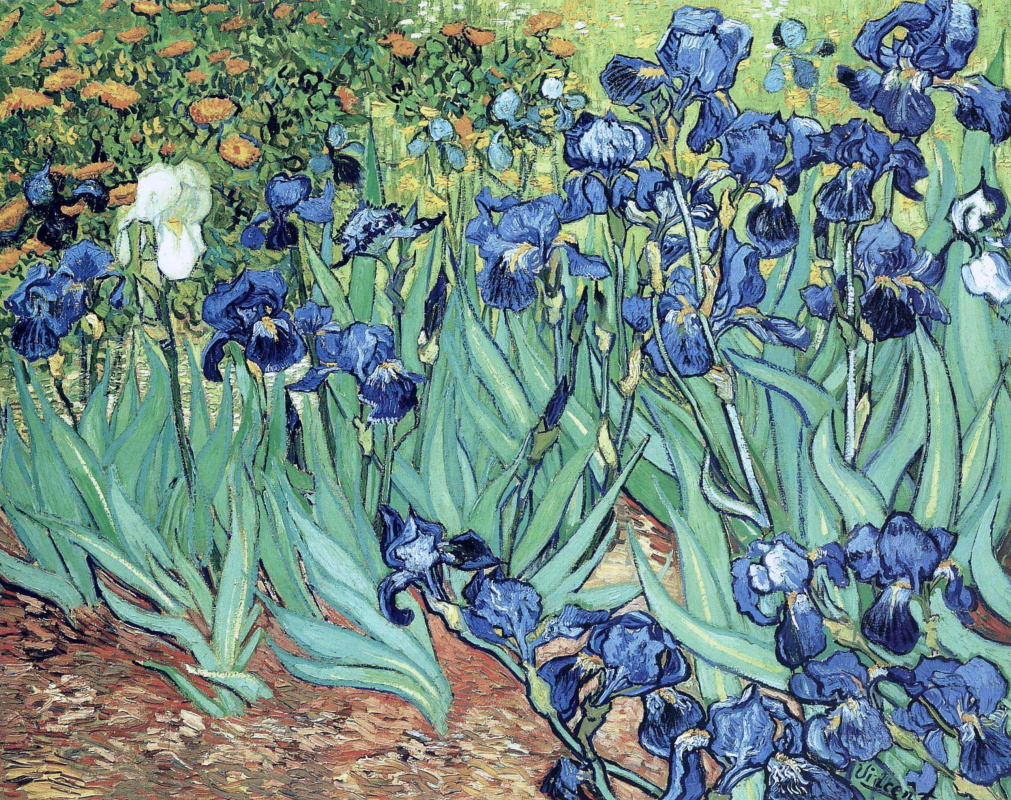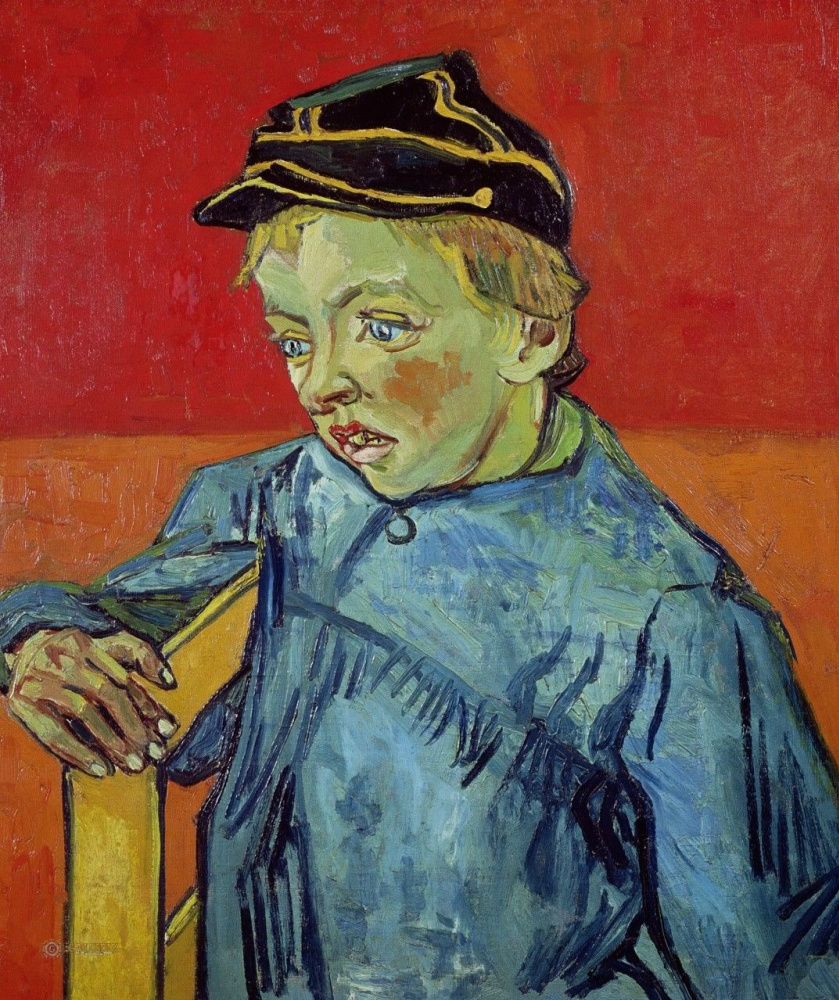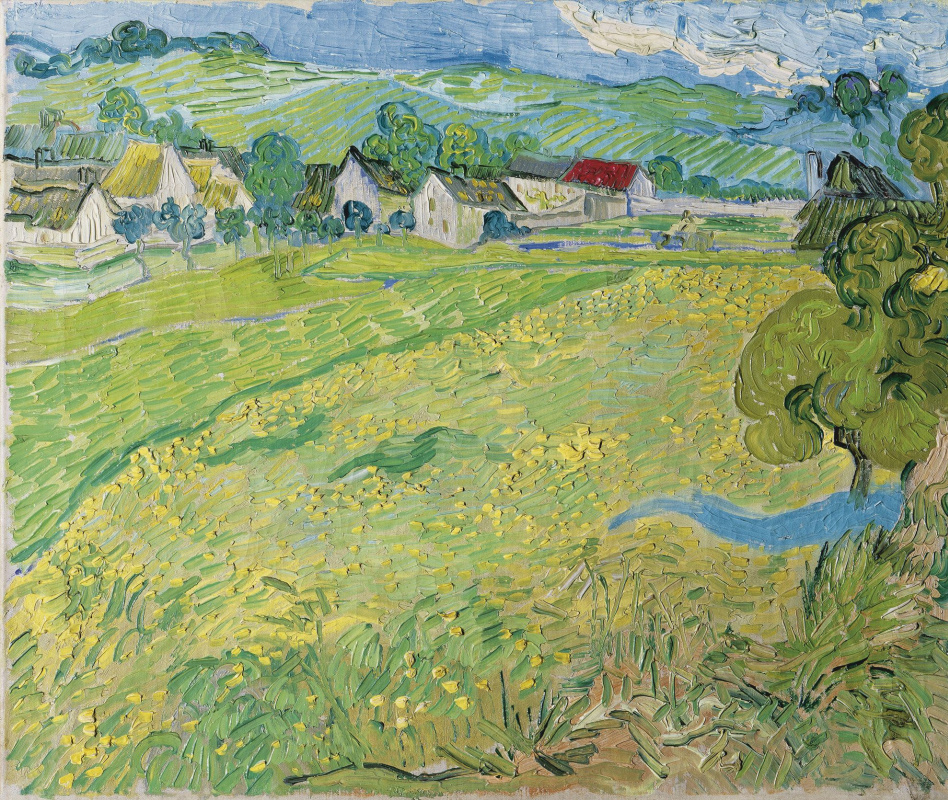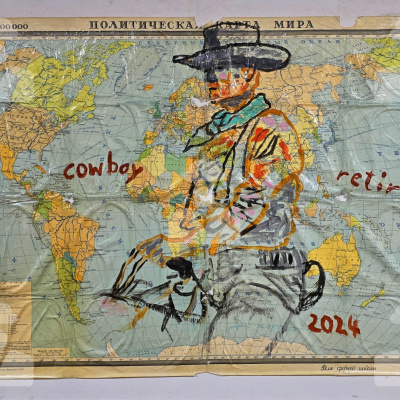Vincent’s works can be found not only in the homeland of absinthe — they are scattered around the world. Chasing the masterpieces by the master, you can draw up an alternative travel map.

This map would contain both the Old and the New Worlds, starry skies and gloomy views, the Seine and Neva, cafés and hotels, planes and bicycles, central skyscrapers and private open-air museums — you will not be bored.
Bedroom in Arles (first version)
October 1888, 72.4×91.3 cm
Vincent Van Gogh Museum
Where? Amsterdam
Why? It houses the largest collection of works by Van Gogh. The composition is built as an artist’s wordless biography: you can get the idea how the stroke of the artist developed, how he travelled through cities in search of himself and his style.
More than 200 paintings by the artist and about 500 of his drawings are stored here. In December 2002 the museum lost two canvases (these are the artist’s early works View of the Sea at Scheveningen and Congregation Leaving the Reformed Church in Nuenen) as someone stole them at night. For years, these paintings were missing. In 2016 they were found, yet the works showed a severe loss. Now, the conservation treatment is completed and the paintings are back on view in the museum.
Here you will see everyday scenes (The Potato Eaters), self-portraits, the works created in moments of joyful outbursts (Bedroom in Arles), still lifes (one of the versions of Sunflowers) — a journey through Van Gogh’s imagination promises to be long and fascinating.
In the neighbourhood: the works by Van Gogh’s colleagues, who at various times were his friends and enemies, are exhibited here. We are talking about the canvases by Paul Gauguin (1, 2), Claude Monet, the posters and drafts by Henri Toulouse-Lautrec and other works by post-impressionists.
Bonus: the museum holds thematic exhibitions dedicated to the art of the 19th century, which help to understand how art progress has developed and what changes have taken place in society. The museum is located on Museumplein Square, not far from it, there is a beautiful lawn with a view of the city, and a stone’s throw from is the Ferris wheel. Moreover, here you can get fit over the weekend, moving along the canals on a bicycle only.
Why? It houses the largest collection of works by Van Gogh. The composition is built as an artist’s wordless biography: you can get the idea how the stroke of the artist developed, how he travelled through cities in search of himself and his style.
More than 200 paintings by the artist and about 500 of his drawings are stored here. In December 2002 the museum lost two canvases (these are the artist’s early works View of the Sea at Scheveningen and Congregation Leaving the Reformed Church in Nuenen) as someone stole them at night. For years, these paintings were missing. In 2016 they were found, yet the works showed a severe loss. Now, the conservation treatment is completed and the paintings are back on view in the museum.
Here you will see everyday scenes (The Potato Eaters), self-portraits, the works created in moments of joyful outbursts (Bedroom in Arles), still lifes (one of the versions of Sunflowers) — a journey through Van Gogh’s imagination promises to be long and fascinating.
In the neighbourhood: the works by Van Gogh’s colleagues, who at various times were his friends and enemies, are exhibited here. We are talking about the canvases by Paul Gauguin (1, 2), Claude Monet, the posters and drafts by Henri Toulouse-Lautrec and other works by post-impressionists.
Bonus: the museum holds thematic exhibitions dedicated to the art of the 19th century, which help to understand how art progress has developed and what changes have taken place in society. The museum is located on Museumplein Square, not far from it, there is a beautiful lawn with a view of the city, and a stone’s throw from is the Ferris wheel. Moreover, here you can get fit over the weekend, moving along the canals on a bicycle only.
Memory of the Garden at Etten
November 1888, 73.5×92.5 cm
The Hermitage
Where: St. Petersburg, Neva Embankment
Why? 14 works by Van Gogh are in Russia: 5 are in the Pushkin Museum, and 9 are in the Hermitage. The works are collected here thanks to the philanthropist Sergei Schukin. After the Red October, his collection was handed over to the State Museum of New Western Art, and from there the work was partly passed to the Hermitage and to the Pushkin Museum.
In the neighbourhood: for more than 250 years, the Hermitage collection has grown from 317 to 3 million works. These are figurines, furniture, home decoration and paintings. However, a run through the history of art in a day will not work: no one can run so fast. Inquisitive minds counted: the halls of the Hermitage are 24 kilometres long, and to see all the exhibits, it will take at least 11 years (this is if everyone lingers for no more than a minute).
Bonus: walk along the Neva and meet especially important cats. Back in the time of Elizabeth, the Hermitage was attacked by rats. They had to get cats to cope with rodents. Catherine II did not like cats, but she valued their professionalism, so no one got rid of them in the Hermitage. Each cat has its name and document; cats are allowed to go everywhere except the showrooms. By the way, until the mid-19th century, only important gentlemen were allowed into the Hermitage, and only in ceremonial dresses; and now, this pleasure is available to everyone. It is worth appreciating this opportunity.
Why? 14 works by Van Gogh are in Russia: 5 are in the Pushkin Museum, and 9 are in the Hermitage. The works are collected here thanks to the philanthropist Sergei Schukin. After the Red October, his collection was handed over to the State Museum of New Western Art, and from there the work was partly passed to the Hermitage and to the Pushkin Museum.
In the neighbourhood: for more than 250 years, the Hermitage collection has grown from 317 to 3 million works. These are figurines, furniture, home decoration and paintings. However, a run through the history of art in a day will not work: no one can run so fast. Inquisitive minds counted: the halls of the Hermitage are 24 kilometres long, and to see all the exhibits, it will take at least 11 years (this is if everyone lingers for no more than a minute).
Bonus: walk along the Neva and meet especially important cats. Back in the time of Elizabeth, the Hermitage was attacked by rats. They had to get cats to cope with rodents. Catherine II did not like cats, but she valued their professionalism, so no one got rid of them in the Hermitage. Each cat has its name and document; cats are allowed to go everywhere except the showrooms. By the way, until the mid-19th century, only important gentlemen were allowed into the Hermitage, and only in ceremonial dresses; and now, this pleasure is available to everyone. It is worth appreciating this opportunity.
Starry night
June 1889, 73.1×92.1 cm
New York Museum of Modern Art (MoMa)
Where: New York, Manhattan
Why? The magical Starry Night has been kept at the Museum since 1941. The artwork was painted from the window of a sanatorium in Arles. In his letter to his brother Theo, Van Gogh explained: "I still need religion. Therefore, I left the house at night and began to draw stars." It’s funny that the artist considered the painting unsuccessful, but now it is one of his most popular works.
In the neighbourhood: Les Demoiselles d’Avignon by Picasso, Persistence of Memory by Dalí, the first version of Dance by Matisse (the second one is in the Hermitage), Christina’s World by Andrew Wyeth.
Bonus: see all the treasures that MoMa almost lost. In 1947, a contract was signed between the MoMa and the Metropolitan Museum, according to which the artworks, as they moved from the modern to the classics category, were supposed to "move" from the Museum of Modern Art to the Metropolitan. The contract was terminated after six years, just in time! Otherwise, MoMA would have remained with half-naked walls.
Why? The magical Starry Night has been kept at the Museum since 1941. The artwork was painted from the window of a sanatorium in Arles. In his letter to his brother Theo, Van Gogh explained: "I still need religion. Therefore, I left the house at night and began to draw stars." It’s funny that the artist considered the painting unsuccessful, but now it is one of his most popular works.
In the neighbourhood: Les Demoiselles d’Avignon by Picasso, Persistence of Memory by Dalí, the first version of Dance by Matisse (the second one is in the Hermitage), Christina’s World by Andrew Wyeth.
Bonus: see all the treasures that MoMa almost lost. In 1947, a contract was signed between the MoMa and the Metropolitan Museum, according to which the artworks, as they moved from the modern to the classics category, were supposed to "move" from the Museum of Modern Art to the Metropolitan. The contract was terminated after six years, just in time! Otherwise, MoMA would have remained with half-naked walls.
Night cafe in Arles
September 1888, 80.7×65 cm
The Kröller-Müller Museum
Where: Netherlands, Otterlo, National Park De Hoge Veluwe
Why? It is the second largest collection of Van Gogh’s paintings (87 exhibits, including the Night Café in Arles) — more of them are only in the Van Gogh Museum in Amsterdam.
In the neighbourhood: Along with the paintings by Van Gogh, the museum presents the artworks by Piet Mondrian, Georges Braque, Lucas Cranach the Elder and many others. The founder of the museum, collector Helene Kröller-Müller was a great connoisseur of Van Gogh and surely a woman with a delicate taste. It appears both from the collection and from the way the space around is decorated.
Bonus: the museum is located in the National Park — this says a lot. On a well-kept territory 300,000 sqm wide, masterpieces of painting and sculpture are collected — from Rodin to Henry Moore. Helene Kröller-Müller advocated the union of art, architecture and nature.
Why? It is the second largest collection of Van Gogh’s paintings (87 exhibits, including the Night Café in Arles) — more of them are only in the Van Gogh Museum in Amsterdam.
In the neighbourhood: Along with the paintings by Van Gogh, the museum presents the artworks by Piet Mondrian, Georges Braque, Lucas Cranach the Elder and many others. The founder of the museum, collector Helene Kröller-Müller was a great connoisseur of Van Gogh and surely a woman with a delicate taste. It appears both from the collection and from the way the space around is decorated.
Bonus: the museum is located in the National Park — this says a lot. On a well-kept territory 300,000 sqm wide, masterpieces of painting and sculpture are collected — from Rodin to Henry Moore. Helene Kröller-Müller advocated the union of art, architecture and nature.
Harvest in Provence
June 1888, 51×60 cm
Museum of Israel
Where: Jerusalem, Givat Ram
Why? View Van Gogh’s works in one of the world’s largest museums — why not? There are two graphics and three paintings by the master, created between 1885 and 1889 (one of them is in the photo above), presented here.
In the neighbourhood: the museum houses more than 500,000 exhibits from different eras. The most ancient finds include a carved female figure, which is called one of the most ancient works of art in the world, and a centuries-old nail, confirming that during the time of Christ, crucifix was practiced.
Bonus: unusual architecture and scale — the area of the museum complex is 81,000 square meters. The Bible Museum, the Hebrew University and the Supreme Court of Israel are nearby.
Why? View Van Gogh’s works in one of the world’s largest museums — why not? There are two graphics and three paintings by the master, created between 1885 and 1889 (one of them is in the photo above), presented here.
In the neighbourhood: the museum houses more than 500,000 exhibits from different eras. The most ancient finds include a carved female figure, which is called one of the most ancient works of art in the world, and a centuries-old nail, confirming that during the time of Christ, crucifix was practiced.
Bonus: unusual architecture and scale — the area of the museum complex is 81,000 square meters. The Bible Museum, the Hebrew University and the Supreme Court of Israel are nearby.
The Starry Night Over the Rhône
September 1888, 92×72.5 cm
Museum d’Orsay
Where: Paris, the left bank of the Seine
Why? It shows Van Gogh’s late works, including the portrait of Dr. Gachet and the Starry Night Over the Rhône. The night picture shows the view not far from the Yellow House, which the artist rented for some time (the painting with the house is stored in the Van Gogh Museum in Amsterdam).
In the neighbourhood: Edgar Degas (1, 2, 3), Jean-François Millet (1, 2, 3), Camille Pissarro (1, 2, 3) and many others — the collection is extensive. And the Museum d’Orsay is located across the river from the Louvre.
Bonus: you would see one of the most beautiful train stations in the world — the Museum d’Orsay is located in it. The station worked from 1900 to 1939, then it was practically idle for several years. In 1971, the building was to be demolished, but the President Georges Pompidou contributed to a more constructive decision: to transform the station into a museum. In d’Orsay, there often performances, concerts and conferences dedicated to temporary exhibitions, take place. In general, the slogan of this place is to watch, listen, delve.
Why? It shows Van Gogh’s late works, including the portrait of Dr. Gachet and the Starry Night Over the Rhône. The night picture shows the view not far from the Yellow House, which the artist rented for some time (the painting with the house is stored in the Van Gogh Museum in Amsterdam).
In the neighbourhood: Edgar Degas (1, 2, 3), Jean-François Millet (1, 2, 3), Camille Pissarro (1, 2, 3) and many others — the collection is extensive. And the Museum d’Orsay is located across the river from the Louvre.
Bonus: you would see one of the most beautiful train stations in the world — the Museum d’Orsay is located in it. The station worked from 1900 to 1939, then it was practically idle for several years. In 1971, the building was to be demolished, but the President Georges Pompidou contributed to a more constructive decision: to transform the station into a museum. In d’Orsay, there often performances, concerts and conferences dedicated to temporary exhibitions, take place. In general, the slogan of this place is to watch, listen, delve.
The Café Terrace at Night (the Kröller-Muller Museum), the Night over the Rhône (d'Orsay) and the Starry Night (MoMa) are pretty much three "star" sisters (the latter being the youngest).
Evening: the end of the day (inspired by Millais)
1889, 72×94 cm
Menard Museum of Art
Where: Komaki City, Central Japan, Aichi Prefecture
Why? See the canvas Evening — The End of the Day, painted after the work of Jean-François Millet.
The museum brings together a large collection of Japanese art and the works by the Impressionists under one roof — there is much to see here.
In the neighbourhood: the works by Japanese artists of the 19—20th centuries — traditional (Nihonga) and west-like (Yōga) ones. The Nihonga style preserved Japanese pictorial traditions, while the supporters of yoga (not to be confused with the Hindu practice) were carried away by European trends. It is interesting to compare how artists of one country practiced art in the same period in different ways.
Bonus: Traveling in Japan is beautiful in itself. For connoisseurs of Van Gogh: in the country there are many works by the artist, though less than used to — one version of Sunflowers burned out in a fire. By the way, do you remember the Portrait of Père Tanguy? This work reminds of the times when travellers brought Japanese art to Europe, and not only collectors liked it, but also it influenced the style of European artists.
Why? See the canvas Evening — The End of the Day, painted after the work of Jean-François Millet.
The museum brings together a large collection of Japanese art and the works by the Impressionists under one roof — there is much to see here.
In the neighbourhood: the works by Japanese artists of the 19—20th centuries — traditional (Nihonga) and west-like (Yōga) ones. The Nihonga style preserved Japanese pictorial traditions, while the supporters of yoga (not to be confused with the Hindu practice) were carried away by European trends. It is interesting to compare how artists of one country practiced art in the same period in different ways.
Bonus: Traveling in Japan is beautiful in itself. For connoisseurs of Van Gogh: in the country there are many works by the artist, though less than used to — one version of Sunflowers burned out in a fire. By the way, do you remember the Portrait of Père Tanguy? This work reminds of the times when travellers brought Japanese art to Europe, and not only collectors liked it, but also it influenced the style of European artists.
Irises
May 1889, 71×93 cm
Getty Museum
Where: Los Angeles, California
Why? Take a look at those Irises and visit the largest museum in California. Oil tycoon Paul Getty left most of his fortune to increase the museum’s collection named after himself, which allowed the centre to buy up the works by old masters at record speeds.
In the neighbourhood: Works by Rubens, Rogier van der Weyden, lots of delightful Boucher. This is a museum with a wide range — from Old Masters to impressionists, and even more. Masterpieces of antiquity are exhibited in a separate room — at the Getty Villa in Malibu.
Bonus: the museum hosts lectures and educational events with cool names. For example, "Stone Pixels: Mosaics Then and Now". Entrance to the museum is free. The centre is built on top of a hill; visitors are brought by three funiculars there. It overlooks Los Angeles — when else can you see the city from above?
Why? Take a look at those Irises and visit the largest museum in California. Oil tycoon Paul Getty left most of his fortune to increase the museum’s collection named after himself, which allowed the centre to buy up the works by old masters at record speeds.
In the neighbourhood: Works by Rubens, Rogier van der Weyden, lots of delightful Boucher. This is a museum with a wide range — from Old Masters to impressionists, and even more. Masterpieces of antiquity are exhibited in a separate room — at the Getty Villa in Malibu.
Bonus: the museum hosts lectures and educational events with cool names. For example, "Stone Pixels: Mosaics Then and Now". Entrance to the museum is free. The centre is built on top of a hill; visitors are brought by three funiculars there. It overlooks Los Angeles — when else can you see the city from above?
Student
December 1888, 63×54 cm
Art Museum of São Paulo
Where: Brazil, São PauloWhy? This country has plenty of beaches, delicious food and the Museum, which contains four works by Van Gogh, painted in San Remy since November 1889 to May 1890. Among them is the portrait of a schoolboy in the photo above.
In the neighbourhood: Diego Velázquez (1), Francisco Goya (1), Amedeo Modigliani (1, 2) and other great artists — there are more than 8000 works in the museum.
Bonus: beautiful architecture, nightlife and Parque do Ibirapuera — an ideal place to have a walk. São Paulo Train Station provides quick access to the ocean.
In Auvers
1890, 55×65 cm
Thyssen-Bornemisza Museum
Where: Madrid, Palace of the Dukes of Villahermos
Why? To see 5 works by Van Gogh created since 1885 to 1890.
In the neighbourhood: Agnolo Bronzino (1), Diego Velázquez, (1), Paul Gauguin (1, 2, 3) and other artists, including Italian primitivists who are not represented in Prado.
Bonus: The Thyssen-Bornemisza Museum is included in the "Golden Triangle of Arts" of the Madrid along with the Prado and the Reina Sofia Art Centre. Everything important is near.
Why? To see 5 works by Van Gogh created since 1885 to 1890.
In the neighbourhood: Agnolo Bronzino (1), Diego Velázquez, (1), Paul Gauguin (1, 2, 3) and other artists, including Italian primitivists who are not represented in Prado.
Bonus: The Thyssen-Bornemisza Museum is included in the "Golden Triangle of Arts" of the Madrid along with the Prado and the Reina Sofia Art Centre. Everything important is near.
Poppy field
June 1890, 82.7×102 cm
The Hague City Museum
Where: The Hague
Why? To see an early still life showing author’s sympathy for the old Dutch, the self-portrait and the Poppy Field. A similar poppy field is in the City Museum of Bremen.
In the neighbourhood: four works by Piet Mondrian, including the famous Mahogany, works by Egon Schiele (1, 2) and Diana with Nymphs by Jan Vermeer.
Bonus: to visit the shores of the North Sea, and see where representatives of the Dutch government and parliament work. The Hague has two beaches that are popular throughout the country — Kijkduin in the west and Scheveningen in the north. Moreover, in The Hague, you must definitely go to Mauritshuis. This is a collection of paintings by Dutch Golden Age artists, where you can meet Vermeer and Rembrandt. The Escher Museum in the former royal palace of Lange Voorhout is an ideal place for optical illusion lovers. However, it is better to visit it on another day, separately from the Van Gogh route: do not put oysters and chocolate in one plate.
Why? To see an early still life showing author’s sympathy for the old Dutch, the self-portrait and the Poppy Field. A similar poppy field is in the City Museum of Bremen.
In the neighbourhood: four works by Piet Mondrian, including the famous Mahogany, works by Egon Schiele (1, 2) and Diana with Nymphs by Jan Vermeer.
Bonus: to visit the shores of the North Sea, and see where representatives of the Dutch government and parliament work. The Hague has two beaches that are popular throughout the country — Kijkduin in the west and Scheveningen in the north. Moreover, in The Hague, you must definitely go to Mauritshuis. This is a collection of paintings by Dutch Golden Age artists, where you can meet Vermeer and Rembrandt. The Escher Museum in the former royal palace of Lange Voorhout is an ideal place for optical illusion lovers. However, it is better to visit it on another day, separately from the Van Gogh route: do not put oysters and chocolate in one plate.
Cover photo: Vincent Van Gogh, Self-Portrait, 1887 (fragment).
Author: Lena Skachkova
Author: Lena Skachkova






